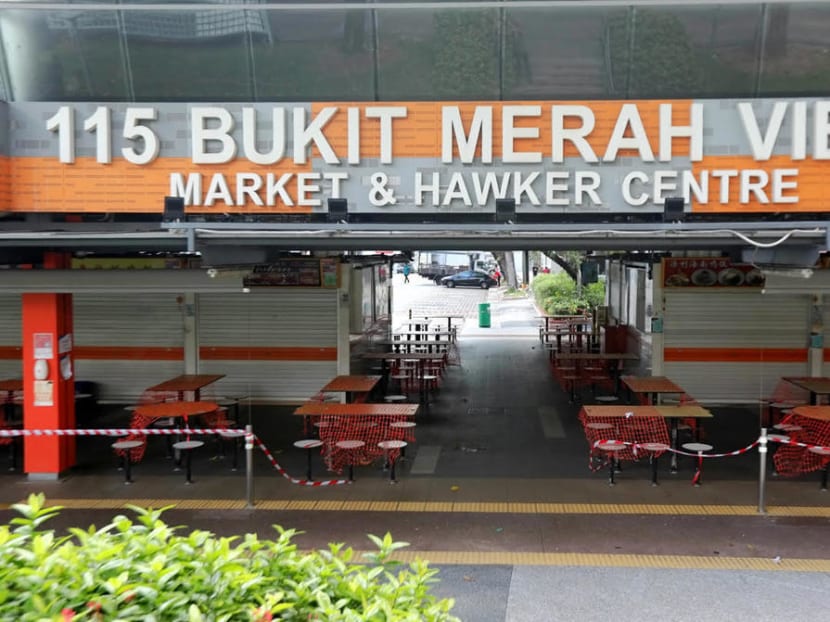Covid-19: MOH updates ‘close contact’ criteria on website, after man was quarantined following 'cumulative exposure' to cases over several days
SINGAPORE — Mr Lim YC, 40, thought that he was being cautious by spending just a few minutes each time he needed to go to Bukit Merah View Market and Food Centre to buy food as he had read about the Covid-19 outbreak there.

Mr Lim YC was told that he had cumulative exposure of at least 10 minutes or more to three confirmed Covid-19 cases after he visited the Bukit Merah View hawker centre on June 2, 4, 8, 9, 10 and 11, 2021.
- A man was placed on a home quarantine order because he had a cumulative exposure of more than 15 minutes to three Covid-19 cases
- MOH updated its definition of close contacts on June 21 to include those with cumulative exposure to suspected Covid-19 cases
- Infectious disease experts said this is just a form of risk stratification
SINGAPORE — Mr Lim YC, 40, thought that he was being cautious by spending just a few minutes each time he needed to go to Bukit Merah View Market and Food Centre to buy food as he had read about the Covid-19 outbreak there.
Mr Lim, an administrative executive, lives within a 10-minute walk of the hawker centre. Despite this, the Ministry of Health (MOH) placed him on an 11-day home quarantine order owing to the risk posed by his cumulative exposure to three Covid-19 cases.
On Monday (June 21), MOH updated its website to make clear that a person who spends a cumulative period of about 15 minutes or more within 2m of a suspected Covid-19 case would be regarded as a close contact.
“Besides the duration and proximity of exposure, MOH also considers the nature and setting of exposure, type of personal protective equipment donned, and other clinical and epidemiological factors when assessing if follow up actions are required for the close contacts,” the website stated.
“Identified close contacts will be advised by MOH officials on the measures they should take.”
In response to TODAY’s queries, MOH clarified on Wednesday that the ministry has always taken into consideration an individual’s cumulative exposure to the same or different cases of coronavirus infection, to determine the individual’s exposure risk and the subsequent public health actions.
“This has consistently been the practice adopted for contact tracing and there was no change in our criteria in defining close contacts,” it said.
This practice was not, however, specified on the MOH website before Monday. The ministry updated its website on Monday to reflect that it takes cumulative exposure into consideration when determining someone’s exposure risk, after Mr Lim had provided feedback to an MOH officer on the issue.
Last Friday, the ministry said that the disease may have been spread at Bukit Merah View Market and Food Centre through people queueing at popular stalls for at least 30 minutes, or by using common facilities such as toilets.
The ministry also said that anyone visiting Covid-19 hot spots on the same day as infected people must get tested and remain isolated until they get their results.
In a letter to TODAY on June 17, Mr Lim said that there was no information on cumulative exposure at that time, so the decision to place him in quarantine caught him by surprise.
He works from home and declined to provide his full name as he did not want people to know of his predicament. TODAY has verified that he was issued with a quarantine order from June 15 to 25.
Mr Lim said that his understanding of the available information at the time he wrote the letter meant that he would only be considered a close contact if he had spent more than 15 minutes with a confirmed Covid-19 case at one time, and not multiple times that add up to 15 minutes or more.
He said that a member of MOH’s contact-tracing team had told him that he had cumulative exposure to three confirmed Covid-19 cases when he visited the hawker centre on June 2, 4, 8, 9, 10 and 11 at around 9.45am each time.
“I went to Bukit Merah View hawker centre on these dates to buy food and leave immediately,” he said.
“I did not even stay for more than five minutes at each stall on each occasion or chat with the hawkers — just grab and go.”
However, Mr Lim said he was told that over the course of the visits on those six days, he had accumulated an exposure time of 10, 30 and 15 minutes with each of the infected individuals respectively.
“If I had known earlier that MOH issues quarantine orders based on cumulative exposure time, I would not have gone to the Bukit Merah View hawker centre to buy food after knowing that there were a few confirmed Covid-19 cases, before the numbers exploded,” he said.
The 115 Bukit Merah View Market and Food Centre was closed by the authorities on June 13 for cleaning after they detected an upsurge in the number of Covid-19 cases there. As of Monday, the total number of confirmed cases from this cluster was 78.
MOH said on June 15 that most of the cases were food-stall workers or their household contacts.
RISK STRATIFICATION
While there is no dispute that the longer one is exposed to an infected person, the greater their chances of becoming infected, infectious diseases experts interviewed by TODAY said that cumulative exposure is just one of a range of factors to be considered.
Professor Dale Fisher, a senior infectious disease consultant at the National University Hospital, said that exposure is a function of how close, how long and how frequent it was.
“Whether it is several brief exposures or one longer exposure; the risk increases. Of course, infectivity of the (patient), masks, ventilation and so on also make a difference,” Dr Fisher said.
Dr Leong Hoe Nam, an infectious disease expert from the Rophi Clinic, agreed with this and said that the virus does not know how to read time.
“Does it wait 15 minutes before it jumps over? A good cough, a good exposure in under one minute is good enough for transmission,” Dr Leong said.
He described putting someone in quarantine because of cumulative exposure as a form of “risk stratification”, which is a way for MOH to draw a line between who is at risk and who is not.
While it might seem strict, Dr Paul Tambyah, president of the Asia Pacific Society of Clinical Microbiology and Infection, said that it needs to be seen in the context of an attempt to break the chains of transmission related to the market — in a setting where there are still significant numbers of unvaccinated individuals.
Dr Fisher said that this is better than an island-wide lock down, which affects everyone. “Such selective identification of contacts demonstrates our strength in preventing spread without large lockdowns.”
The experts also reiterated MOH’s advisory that there is no need to avoid places where confirmed Covid-19 cases have been.
“The aim is for people who had been in those places at the stated times to seek medical attention if unwell,” Dr Tambyah said.
“The exposure has already occurred so there is no reason for people to avoid the place moving forward. They are reporting ‘after the event’ when an infectious person has already left the place.”
Instead, what people could consider doing if they are worried about being put in quarantine because of cumulative exposure is keep 2m or 3m away from anyone, Dr Leong said.
“The bluetooth (from the TraceTogether token) will not pick you up and you are safe. That is also called safe or social distancing,” he said.
The alternative is to avoid going out unless necessary, Dr Leong said.
When asked if there might be better ways of curbing the spread of infection, the experts said that aside from a total lockdown, it would be to achieve a high rate of vaccination.
“In the meantime, we must control the spread still, but the end is in sight,” Dr Fisher said.
“Using such thorough contact tracing and quarantine is inconvenient for a few, but the alternative is blunter social restrictions, which we wish to ease for the sake of people’s livelihoods.”
CLARIFICATION: An earlier version of this report said that MOH had updated its definition of close contacts to include those with cumulative exposure to suspected Covid-19 cases. MOH has since clarified that this practice has been ongoing and there has been no change to its procedures, but that its website was updated to make the information public.








